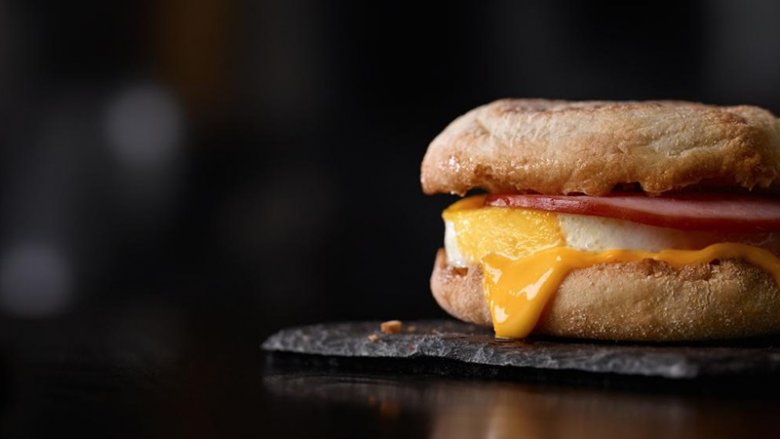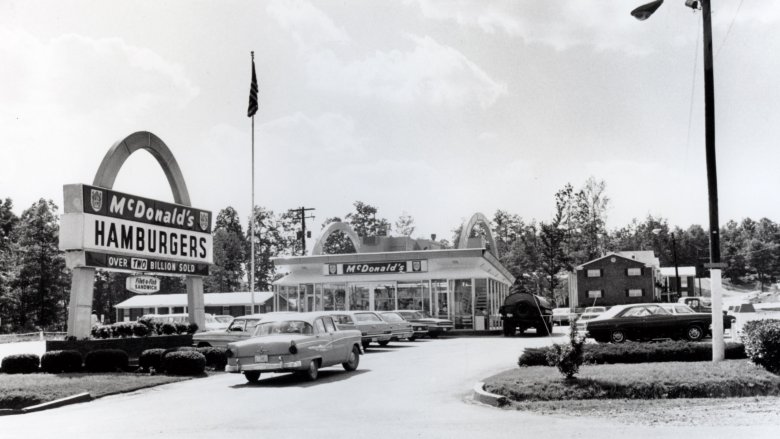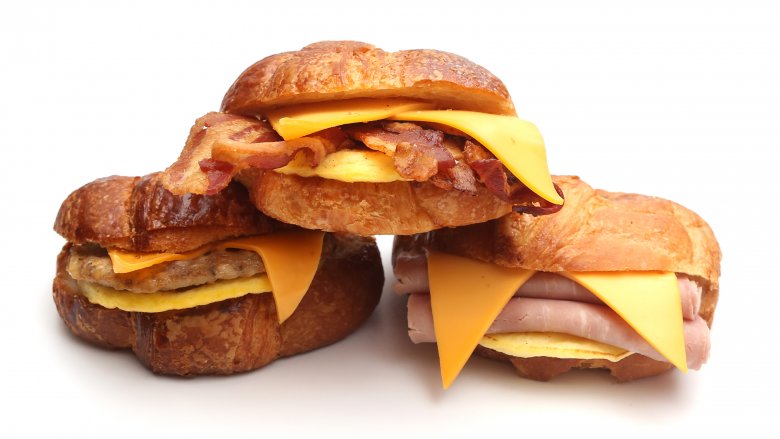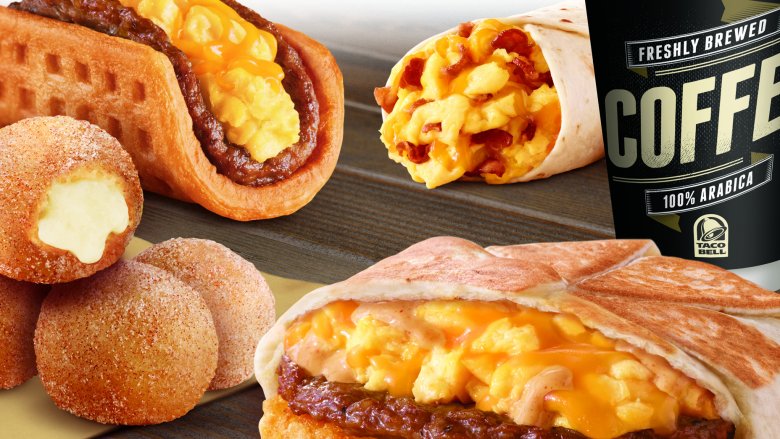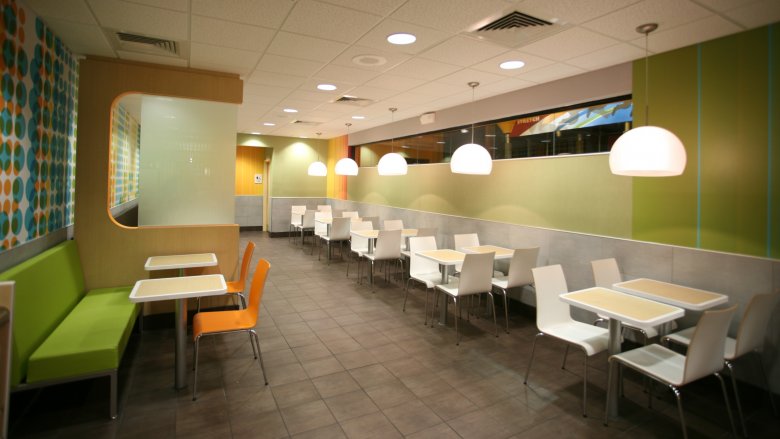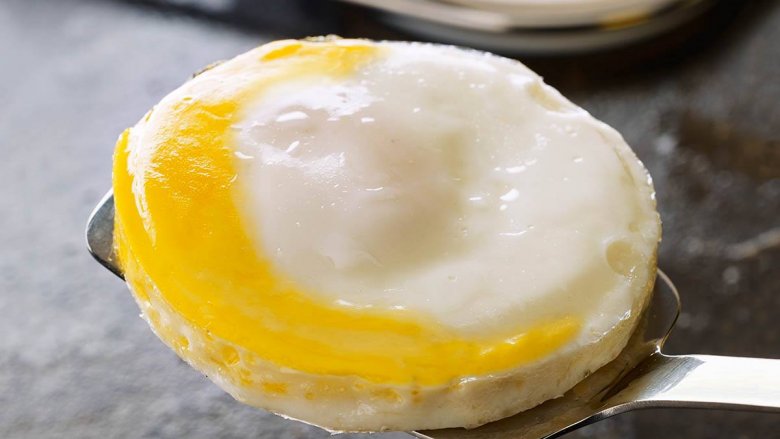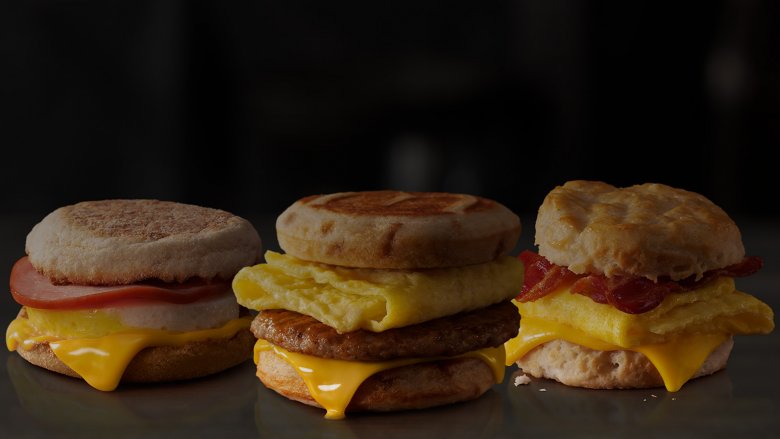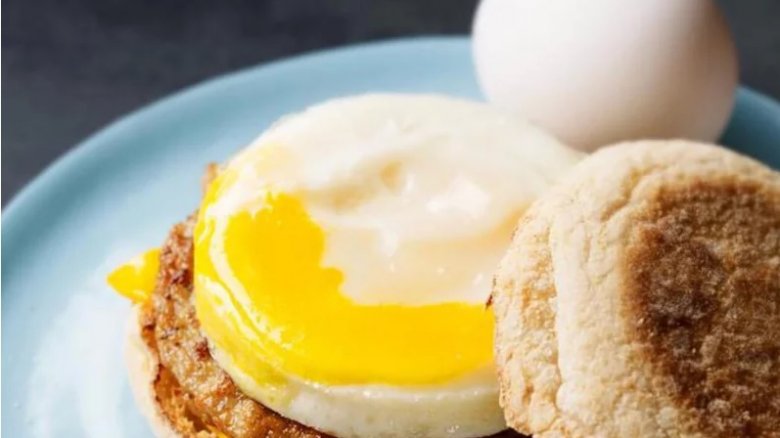What You Don't Know About McDonald's Famous Egg McMuffin
On a Tuesday in October 2015, McDonald's made a move that would change the course of culinary history forever.
Before that fateful day, the hangry and hungover would have to scramble out of bed and speed to their nearest McDonald's. For you see, there was once a time when McDonald's stopped selling their prized Egg McMuffins at exactly 10:30 a.m. every day. Millions would miss this draconian deadline, and head-home empty handed or worse — with some miserable non-breakfasty alternative, like the Filet-o-Fish.
It took years of loyal customer pleading, petitioning, and Tweeting to convince McDonald's to start offering extended breakfast hours. Thanks to these brave breakfast heroes, plus a slump in sales, the fast-food empire finally introduced an all-day breakfast menu that has hung around ever since. Nowadays, you can roll up to most McDonald's any time of day or night to order an Egg McMuffin.
Because McMuffins are more accessible in the U.S. than kumquats and health care, it's easy to take these tasty 'lil breakfast buddies for granted. But the McDonald's Egg McMuffin is anything but an ordinary pile of eggs, cheese, and Canadian bacon. Read on to learn the fascinating truth of McDonald's Egg McMuffin.
The Egg McMuffin's inventor had to pull a few tricks to get it on the menu
Like personal computers, bicycles, and other world-changing inventions, the Egg McMuffin wasn't initially appreciated for the genius idea it was. "... it was a crazy idea — a breakfast sandwich," McDonald's President Ray Kroc wrote in his memoir, Grinding It Out: The Making of McDonald's.
The aforementioned "crazy idea" was dreamed up by one Herb Peterson, a McDonald's franchise owner with three locations in Santa Barbara, California. A fan of Egg Benedicts, Peterson wanted to design an Eggs Benny-inspired sandwich that would give him an excuse to open his restaurants before lunchtime. Thus, in 1971, the pioneering restaurateur invented the Egg McMuffin: that tantalizing tower of toasted English muffin, egg, Canadian bacon, and melted American cheese.
Peterson knew he had a masterpiece on his hands, but rightly predicted others might need convincing. He persuaded Kroc to visit Santa Barbara to take a look at something, but refused to tell him what it was. The McDonald's president was hesitant at first, but was "sold" after that first bite.
It took six years to get the Egg McMuffin on menus of McDonald's nationwide. By 1976, however, Americans were hooked. Soon, McDonald's extended its hours and beefed up its breakfast menu with hotcakes, hash browns, and the like.
The Egg McMuffin single-handedly spearheaded the fast-food breakfast industry
The Egg McMuffin entered the world when most fast food establishments didn't open until 11 a.m. and when eating fast food for breakfast was kind of weird. Before the Egg McMuffin, "breakfast tended to be a sit-down occasion," Bob Goldin, food industry consultant at Technomic, explained on All Things Considered. Families gathered around the breakfast table for pancakes, eggs, and bacon. Running late? You might be out of luck and forced to head to work hungry.
The breakfast sandwich fulfilled a need the busy American worker had been craving for too long: a quick, cheap, convenient breakfast that could be eaten on-the-go. Nowadays, most Americans wouldn't have it any other way: consumers expect that breakfast be one of the most convenient meals of the day, Business Insider reports. According to The New York Times, millennials surveyed considered even cereal to be too inconvenient a breakfast choice, since it requires clean up.
... and initiated a fierce fast-food breakfast war
Following the success of the Egg McMuffin, McDonald's breakfast tactics were predictably imitated by competitors. In 1983, Burger King launched the Croissan'Wich, a breakfast sandwich built from a croissant, egg and cheese with an optional choice of meat. Lagging behind was Taco Bell, which introduced a breakfast menu with breakfast tacos, burritos, and the short-lived waffle taco in 2014. Competitors like Wendy's, Jack-in-the-Box, Chick-fil-A, and Subway also rolled out their own breakfast menus.
The result? A fierce breakfast war that rages on to this day. With breakfast now the most profitable area in the fast-food industry, franchises are trying everything from dropping prices to rolling out bigger and better takes on the breakfast sandwich to get ahead.
For all their efforts, McDonald's continues to reign as the most popular fast-food breakfast spot in the U.S. According to Foursquare Swarm (via Business Insider) McDonald's ranks number one for breakfast in every state in the U.S. except for Oklahoma. Oklahomans (those weirdos) preferred Sonic for breakfast, but ranked McDonald's as a close second.
The Egg McMuffin may have saved McDonald's from collapse
Here's some breakfast food for thought: Without the Egg McMuffin, there might not even be a McDonald's anymore.
Before bringing out the game-changing all-day breakfast, McDonald's was floundering. For 13 consecutive months beginning in 2012, McDonald's saw same-store sales fall or remain flat. Ronald McDonald got an eerie new makeover. The restaurant tried and failed at making a sad "artisan" chicken sandwich. Customers left and right were ditching hamburgers in favor of tacos.
But when McDonald's unleashed the all-day Egg McMuffin, everything changed. Following the extension of breakfast hours, McDonald's saw same-store sales open for at least 13 months rise by 5.7 percent. The increase in sales was the largest McDonald's had seen in nearly four years. Now, McDonald's breakfast counts for 25 percent of its U.S. sales.
In the end, McDonald's couldn't win back customers with promises of artisanal ingredients or cage-free eggs. It won back customers with the Egg McMuffin, because the Egg McMuffin is made with perfectly round eggs and fairy dust.
Here's why the eggs are perfectly round, every time
Speaking of perfectly round eggs, let's go back to 1971, when Herb Peterson was playing around in his kitchen, experimenting with hundreds of different prototypes of the breakfast sandwich. Herb knew that his beloved Eggs Benedict was far too messy to be scarfed down with one hand on your way to work. He solved the issue of gooey hollandaise sauce by replacing it with cheese and butter. But making the eggs portable was trickier.
As David Peterson, Herb's son, recalled, "The real genius was in the egg ring," says David, "because how do you keep the egg from going everywhere?" According to David, his father commissioned a local blacksmith to create a stainless-steel, teflon-coated, six-ring tool to cook the egg into a neat, perfect circle that fit onto the muffin perfectly.
To this day, McDonald's use a similar contraption to create perfectly round eggs for their Egg McMuffins. McDonald's McMuffin masters heat the grill with egg rings on top, then douse the grill in butter. Once the grill is sizzling, chefs crack open fresh, whole eggs onto the grill. They then break the yolk of each egg to make sure they cook evenly and spray the eggs with water so they can poach. After two minutes, voilà: round eggs that look almost too beautiful to be eaten. But you eat them anyway.
The McMuffin is the only egg-based McDonald's menu item that uses fresh eggs
Because the Egg McMuffin's egg is a little too perfect, customers have speculated that they are fake or somehow sliced from a giant egg roll. To dispel some of the rumors, McDonald's invited former MythBusters behind the scenes.
In the video, Imahara learns that Egg McMuffins come from fresh-shell eggs. These Grade A eggs are cracked fresh and cooked into Egg McMuffins. But what about all the other McDonald's menu items with eggs on the menu? Turns out, the Egg McMuffin is the only one that can boast fresh eggs as an ingredient.
Most egg dishes at McDonald's, including the biscuit sandwiches, the bagel sandwiches, and the McGriddles, are made with something called a "folded egg." According to the ingredients list, these are comprised of liquid eggs, nonfat milk, modified food starch, and citric acid. Folded eggs are cooked in a third-party supplier, frozen, and shipped to McDonald's stores.
The sausage burrito egg filling comes pre-cooked, liquid eggs with additives from a supplier before being frozen and shipped to McDonald's. Scrambled eggs are made from liquid eggs and simmered on site. And finally, egg whites for the Egg White Delight McMuffin are whipped up with liquid egg whites, not freshly cracked but at least free of sketchy preservatives.
It's not as unhealthy as you think
McDonald's gets a bad rap as being the quintessential purveyor of unhealthy American cuisine. To the company's credit — they're making major strides to provide healthier options these days.
But long before ditching the artificial preservatives in McNuggets and soft serve and taking soda off the Happy Meal menu, McDonald's offered at least one kinda healthy food: the Egg McMuffin.
Let's break down its nutritional anatomy. The Egg McMuffin is made with a real egg that is poached and not fried. Your classic sandwich has a small circle of Canadian bacon, a single slice of American cheese, and real butter. Together, this totals to 290 calories, 12 grams of fat with about six of those grams coming from saturated fat, 17 grams of protein (34 percent), and 29 grams of carbs (10 percent).
In terms of unhealthy breakfast options, you could definitely do a lot worse. Consider, for example, the Burger King Croissan'which with double sausage, egg, and cheese, which clocks in at around 700 calories with 51 grams of fat (20 of which are saturated). Or McDonald's own steak, egg, and cheese biscuit, with its 530 calories and 30 grams of fat (15 of which are saturated). And don't even get us started on sugary, empty-calorie donuts.
You can trace its origins to 19th century London
For a long as humandkind has longed for something quick, portable, fulfilling, and eggy before scurrying off to work, there have been breakfast sandwiches. The earliest ancestor of the Egg McMuffin was born in 19th century London, speculates historian Heather Arndt-Anderson in an interview with The Washington Post.
London and the rest of the U.K. were in the grips of the Industrial Revolution, when diners left the plentiful breakfast ingredients of their farms and moved to cities to work in factories. It was a time of innovations that would change society, including the cotton gin, electricity, and — of course — the breakfast sandwich.
As the hoards of British factories headed to work, street vendors began hawking "bap" sandwiches, Arndt-Anderson recounted. These were soft rolls filled with fried egg, bacon or sausage, and occasionally cheese. Street vendors would serve baps with old-timey British accents and a cup of coffee. Because they consisted of inexpensive ingredients and didn't cost much to make, the bap was hugely successful. By keeping factory workers cheerful, full, and on-time for work, the bap breakfast sandwich fueled the Industrial Revolution.
It's early ancestor, the Denver Sandwich, traveled across the U.S. during westward expansion
As settlers crossed the ocean to the Americas, they brought along their hunger for a quick, convenient, low-cost breakfast. The earliest incarnation of the breakfast sandwich may have been the Denver or "Western" sandwich — scrambled egg with ham, onion, and green pepper tucked between two toasted slices of white bread.
The Denver was named as the first American breakfast sandwich by the Oxford Encyclopedia of Food and Drink in America. Historians credit the invention of the dish to early pioneers during Westward expansion. While farmers and other stationary settlers might have access to fresh ingredients to craft into fresh breads, pancakes, meats, and coffee every morning, covered wagon travelers had to make due with less resources as they braved the Oregon Trail.
As the story goes, eggs tended to go bad during long, dusty wagon trips. In an attempt to recover the eggs while hiding that unpleasant rotting flavor, settlers cooked them with onions and peppers. The Western/Denver sandwich remains popular to this day in diners across America, though it's now more often served in omelette form with slices of breads on the side.
